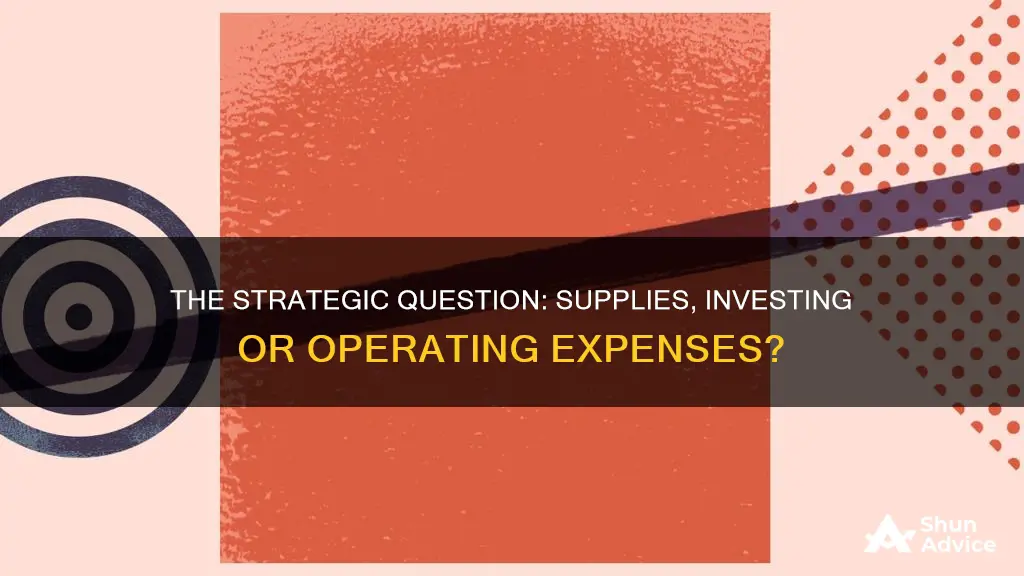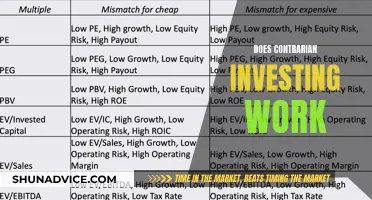
Whether buying supplies is considered an investment or an operating activity depends on the nature of the supplies and the context of the purchase.
In general, operating activities are the functions of a business directly related to providing its goods and services to the market. These include manufacturing, distributing, marketing, and selling a product or service. Operating activities generate the majority of a company's cash flow and determine its profitability.
On the other hand, investing activities refer to transactions that affect a company's assets and are related to long-term investments. This includes purchases of physical assets, investments in securities, or the sale of securities or assets.
Now, when a company buys supplies, it can be considered an operating activity if the supplies are directly related to the production or delivery of its goods and services. For example, if a clothing company purchases fabric to make garments, this would be an operating activity as it is essential for their core business.
However, if a company buys supplies that are not directly related to its core business but are instead used for long-term investments or expansion, it may be considered an investing activity. For instance, if a company purchases new equipment or expands its facilities, this could be classified as an investing activity as it affects their assets and is a long-term investment.
So, in summary, buying supplies can be considered an investing or operating activity depending on the nature of the supplies and whether they are used for the day-to-day operations or long-term investments of the company.
What You'll Learn
- Buying supplies is an operating activity if it's directly related to providing goods and services to the market
- Buying supplies can be an investing activity if it's a long-term investment
- Operating activities can be contrasted with investing and financing activities
- Investing activities are transactions that affect a business's assets
- Financing activities are transactions that affect the owner's equity and long-term creditors

Buying supplies is an operating activity if it's directly related to providing goods and services to the market
Operating activities are the daily activities of a company involved in producing and selling its products, generating revenues, and general administrative and maintenance activities. These activities can be found on a company's financial statements, specifically the cash flow statement and the income statement. Operating activities will generally provide the majority of a company's cash flow and largely determine whether it is profitable.
Some common operating activities include cash receipts from goods sold, payments to employees, taxes, and payments to suppliers. For example, an apparel store's operating activities might include buying materials from suppliers and paying for labour to produce clothing, paying to transport the materials and clothes to warehouses and retail stores, and paying employees to work in these locations.
Other less common operating activities include fines or cash settlements from lawsuits, refunds, and money collected from insurance claims. Revenue-generating activities, marketing and advertising activities, administration activities, maintenance activities, and customer service activities are also considered operating activities.
Therefore, buying supplies is an operating activity if it is directly related to providing goods and services to the market, as it is a part of the company's core business activities and contributes to generating revenues.
Employee Compensation: Strategic Investment or Necessary Expense?
You may want to see also

Buying supplies can be an investing activity if it's a long-term investment
Buying supplies can be classified as an operating activity or an investing activity, depending on the context and nature of the purchase. Operating activities are the functions of a business directly related to providing its goods and services to the market, such as manufacturing, distributing, marketing, and selling a product. On the other hand, investing activities refer to transactions that impact a company's assets, including the acquisition or disposal of long-term assets.
In certain situations, buying supplies can be considered an investing activity if it is a long-term investment. This means that the supplies are not intended for immediate consumption or use in the production process, but rather are seen as investments that will deliver value in the future. For example, a company might purchase supplies in bulk at a discounted price, intending to use them for production over a more extended period. In this case, the purchase of supplies would be considered a long-term investment and, therefore, an investing activity.
Another scenario where buying supplies could be viewed as an investing activity is when the supplies are unique or specialised and are expected to appreciate in value over time. For instance, a company dealing in antique furniture might acquire rare or vintage pieces with the intention of holding them as investments. In such cases, the acquisition of these supplies would be categorised as an investing activity.
It's worth noting that the distinction between operating and investing activities is essential for financial reporting and analysis. The classification of a transaction as an operating or investing activity has implications for how it is accounted for and presented in a company's financial statements, particularly in the cash flow statement.
In summary, while buying supplies typically falls under operating activities, it can be considered an investing activity if it meets the criteria of a long-term investment. This classification is significant for understanding the financial health and strategy of a company.
Understanding Investment Pay Periods: Unlocking the Timeline of Returns
You may want to see also

Operating activities can be contrasted with investing and financing activities
Operating activities, investing activities, and financing activities are the three distinct categories of cash flow that a business engages in. These activities are presented in a company's statement of cash flows, which allows financial statement users to assess a company's strategy, profitability, and ability to stay in business. Operating activities can be contrasted with investing and financing activities as follows:
Operating Activities
Operating activities are the functions of a business directly related to providing its goods and services to the market. These are the company's core business activities, such as manufacturing, distributing, marketing, and selling a product or service. Operating activities generally provide the majority of a company's cash flow and largely determine its profitability. Some common operating activities include cash receipts from goods sold, payments to employees, taxes, and payments to suppliers.
Investing Activities
Investing activities are cash business transactions related to a business's investments in long-term assets. They can usually be identified from changes in the Fixed Assets section of the long-term assets section of the balance sheet. Some examples of investing cash flows are payments for the purchase of land, buildings, equipment, and other investment assets, and cash receipts from the sale of these assets. When a company makes long-term investments, it is assumed to be using or reducing its cash and cash equivalents, and these investments are reported as negative amounts in the cash flows from investing activities section.
Financing Activities
Financing activities are cash transactions related to the business raising money from debt or stock or repaying that debt. They can be identified from changes in long-term liabilities and equity. Examples of financing cash flows include cash proceeds from the issuance of debt instruments, cash proceeds from the issuance of capital stock, cash payments for dividend distributions, and principal repayment or redemption of notes or bonds payable.
Contrasting Operating Activities with Investing and Financing Activities
Operating activities are the daily activities of a company involved in producing and selling its products or services, generating revenues, and general administrative and maintenance activities. On the other hand, investing and financing activities are functions of a company not directly related to the provision of goods and services but help the company function optimally over the longer term. For instance, the issuance of stock or bonds by a company is not counted as an operating activity.
Key operating activities for a company include manufacturing, sales, advertising, and marketing activities, while investing and financing activities involve long-term asset management and capital structure decisions. Operating activities produce revenues for a company through manufacturing and selling products or services, while investing and financing activities do not directly generate revenues but are crucial for the company's long-term financial health and strategic direction.
The Future of Tech Investing: How Financial Tools are Transforming the Game
You may want to see also

Investing activities are transactions that affect a business's assets
When a company makes long-term investments or acquires property, equipment, or vehicles, it is assumed to be using or reducing its cash and cash equivalents. Therefore, these investments and capital expenditures are reported as negative amounts in the cash flows from investing activities section of the SCF. On the other hand, when a company sells any of its long-term investments or assets, it is assumed to be providing or increasing its cash and cash equivalents, and the cash received is reported as a positive amount in the SCF.
Some examples of investing activities include the purchase of fixed assets, investments such as stocks or securities, and lending money, which all result in negative cash flow. Positive cash flow investing activities include the sale of fixed assets and the sale of investment securities.
Investing activities are important because they show how a company is allocating cash for the long term. For example, a company may invest in fixed assets such as property, plant, and equipment to grow the business, which may help generate positive cash flow in the long term.
SM Investments' Will Howell: Navigating the Philippines' Post-Pandemic Economy
You may want to see also

Financing activities are transactions that affect the owner's equity and long-term creditors
Buying supplies is an operating activity, which is distinct from financing activities. Financing activities are transactions that affect the owner's equity and long-term creditors. They are a crucial aspect of a company's financial health and capital management.
Financing activities refer to business transactions involving long-term liabilities, owners' equity, and short-term debts. These activities are recorded in the cash flow statement, which is one of the three main financial statements that provide insight into a company's financial health. The other two statements are the balance sheet and the income statement.
The cash flow statement includes three sections: operating activities, investing activities, and financing activities. The financing activities section specifically focuses on the transactions between a company and its investors and creditors. It shows how a company generates funding and manages its capital to finance its operations, pay off debts, and disburse dividends.
Examples of financing activities include issuing or repurchasing stocks, borrowing or repaying short-term and long-term loans, and paying cash dividends. These activities can result in either cash inflows or outflows for the company.
Financing activities are an essential aspect of a company's financial strategy and provide valuable information about its capital structure and financial management.
Venture Cultivation: The Power of Investing Time in New Business Endeavors
You may want to see also
Frequently asked questions
Buying supplies is an operating activity. Operating activities are the functions of a business directly related to providing its goods and services to the market. Buying supplies is a cost that does not involve financing or investing and is, therefore, an operating activity.
Other examples of operating activities include:
- Revenue-generating activities, such as selling a product or service
- Marketing and advertising activities, such as hiring a graphic designer or starting an ad campaign
- Administration activities, such as accounting or information technology tasks
- Maintenance activities, such as facilities maintenance
- Customer service activities, such as interacting with customers or ordering supplies
Operating activities can result in both operating revenues and operating expenses, impacting a company's cash flow. While a company's goal is to create more revenue than debt or expense, fewer expenses do not always lead to more revenue. To produce operating revenues, a business will need to experience cash outflow. For example, a company will need to purchase materials to make their products, sell them, and bring in revenue. Therefore, the key to operating activities is to create a healthy balance.







